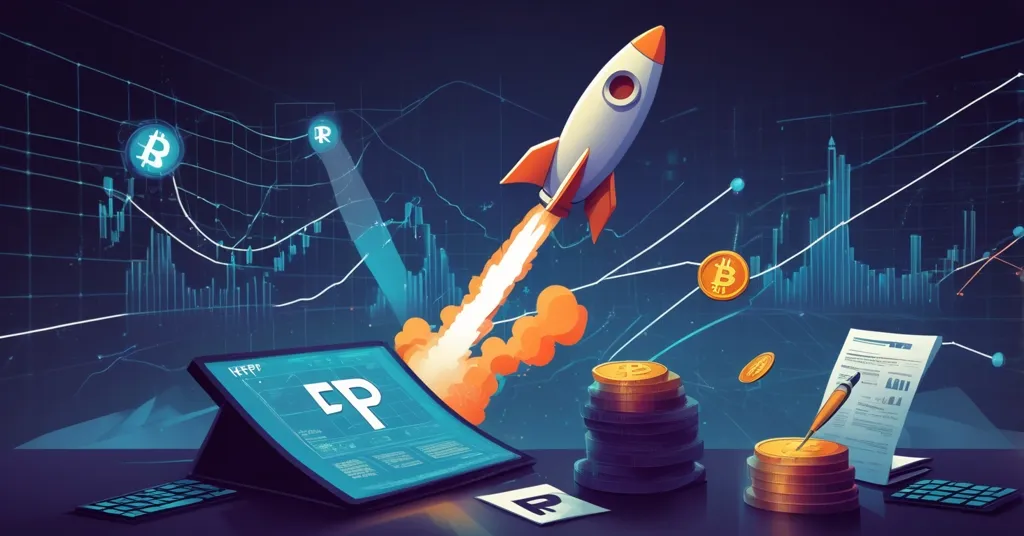XRP Surges 10% on ETF Hype: Can It Hit $10 or Is $1,000 Pure Fantasy?

XRP Price Surge: ETF Hype Ignites Rally—Is $1,000 Realistic?
XRP is stealing the spotlight with a sharp 10% price jump in just 24 hours, as trading volumes nearly double, fueled by the prospect of two spot XRP ETFs from Canary Capital and 21Shares. With a 20-day SEC approval countdown underway, the market is buzzing with speculation—could this propel XRP to unimaginable heights, or is it just another bubble waiting to burst? Meanwhile, a side note on Bitcoin Hyper ($HYPER) offers a glimpse into broader crypto innovation.
- XRP Rally: Up 10% in a day with trading volumes soaring, driven by ETF anticipation.
- ETF Filings: Canary Capital (XRPC) and 21Shares await SEC approval within 20 days for Nasdaq listing.
- Price Outlook: Short-term target of $3.60 (41% upside), $10 plausible long-term, but $1,000 is sheer fantasy.
XRP’s Rally: What’s Behind the Surge?
The native token of the Ripple network, XRP, has long been a polarizing player in the crypto space. Designed for fast, low-cost cross-border payments, it’s often hailed as a bridge between traditional finance and blockchain tech. Yet, it’s been shackled by a years-long legal battle with the U.S. Securities and Exchange Commission (SEC) over whether it qualifies as a security. Despite this overhang, XRP has just posted a 10% price increase in a mere 24 hours, with trading volumes nearly doubling as investors pile in. The catalyst? Anticipation for two spot XRP exchange-traded funds (ETFs) that could open the floodgates to institutional money. For the uninitiated, an ETF is a financial product traded on stock exchanges that tracks the price of an asset like XRP, letting investors gain exposure without directly owning the cryptocurrency—think of it as a highway connecting Wall Street to the crypto frontier.
On the technical side, XRP’s price action looks promising. It recently broke out of a symmetrical triangle on the 4-hour chart—a pattern where price swings narrow over time, often signaling a big move. Support holds firm at $2.2, while resistance looms at $2.35 alongside the 200-day Exponential Moving Average (EMA), a key indicator of long-term trends. If momentum pushes past $2.65, analysts see a potential 41% upside to $3.60 in the near term. But let’s not get carried away—other indicators like the Relative Strength Index (RSI) could signal overbought conditions, hinting at a pullback if buying pressure fizzles. And with XRP’s history of pump-and-dump cycles tied to lawsuit updates, whales could easily tank the price on a whim. The market sentiment on social platforms like X is electric, with some calling this the start of a “Ripple revival,” but skepticism runs deep among those burned by past volatility. For a deeper dive into the speculative frenzy, check out this analysis on XRP price predictions.
Spot XRP ETFs: Game-Changer or Regulatory Mirage?
Let’s dig into the heart of the hype. Canary Capital and 21Shares have filed Form 8(a) with the SEC, a critical step that triggers a 20-day review period to decide if their spot XRP ETFs can list on Nasdaq. Canary’s fund will trade under the ticker XRPC, while 21Shares’ ticker remains under wraps. Bloomberg ETF expert Eric Balchunas has highlighted the significance of this filing, noting it marks the official countdown for potential approval. There’s already a precursor in the market—the REX-Osprey XRP ETF (XRPR), which has accumulated over $100 million in assets since its launch. If these new ETFs get the nod, they could catapult XRP into the mainstream, mirroring the impact of Bitcoin and Ethereum spot ETFs, which have pulled in billions since their 2023 debuts (Bitcoin ETFs alone saw over $17 billion in inflows).
Why does this matter? Spot ETFs directly track XRP’s price, offering a familiar vehicle for traditional investors wary of crypto’s wild swings or tech barriers. They could signal a thawing in regulatory hostility toward Ripple and drive a wave of adoption. But here’s the harsh reality check: the SEC isn’t exactly Ripple’s biggest fan. Approval is no sure bet, and a rejection could slam XRP’s price below $2, reigniting fears of regulatory suppression. Even if approved, lingering uncertainty might deter cautious institutions. As a Bitcoin maximalist, I’ll admit XRP’s centralized design—controlled largely by Ripple—clashes with the decentralization I hold sacred. Still, its niche in cross-border payments fills a gap Bitcoin doesn’t aim to tackle, and ETF legitimacy could be a pragmatic win for broader crypto acceptance.
Ripple’s Legal Battle: A Persistent Shadow
XRP’s journey hasn’t been smooth sailing, thanks to a grueling legal standoff with the SEC that kicked off in 2020. The agency accused Ripple of selling XRP as an unregistered security, a charge that’s kept the token’s price under pressure while Bitcoin and Ethereum hit new highs. A pivotal moment came in 2023 when a court ruled that XRP isn’t always a security—specifically, sales on public exchanges don’t meet the criteria, though institutional sales remain murky. This partial victory boosted XRP temporarily, but the case isn’t fully resolved, with appeals and fines still on the table. This legal cloud directly impacts ETF approval odds; the SEC might hesitate to greenlight funds for an asset still in limbo, fearing it sets a precedent for other disputed tokens.
For investors, this saga is a double-edged sword. On one hand, a favorable ETF decision could be seen as the SEC softening its stance, potentially clearing XRP’s path to wider adoption. On the other, any negative ruling or delay could spark a sell-off, reminding us that regulators still hold immense power over crypto’s fate. From a decentralization standpoint, I’m torn—XRP’s reliance on Ripple’s decisions feels antithetical to the ethos of permissionless systems like Bitcoin. Yet, if ETFs can pull XRP out of the regulatory doghouse, it might pave the way for more blockchain projects to challenge the status quo. The next 20 days could be make-or-break.
Price Predictions: Realism vs. Delusional Hopium
Let’s talk numbers and cut through the noise. Short-term, XRP’s breakout suggests a potential climb to $3.60—a 41% upside—if it sustains momentum past $2.65. Long-term, with ETF-driven institutional adoption, a rise to $10 isn’t out of the question, especially if Ripple’s legal woes fade. Historical context supports cautious optimism; XRP hit nearly $3.40 during the 2017 bull run on pure speculation, so $10 with real backing isn’t crazy. But let’s address the absurdity floating around—a $1,000 XRP. Frankly, that’s not just hopium; it’s a full-blown delusion unless Ripple rewrites the laws of economics or XRP’s utility explodes beyond imagination. With a circulating supply of over 50 billion tokens, a $1,000 price implies a market cap of $50 trillion—more than Bitcoin, Ethereum, and most global stock indices combined. Get real.
Playing devil’s advocate, even modest gains aren’t guaranteed. Crypto markets are notorious for manipulation, and XRP’s past pumps often end in brutal dumps when news cycles cool. If the SEC rejects these ETFs, or if major holders (whales) cash out at resistance levels, we could see a swift retreat to sub-$2 levels. Community chatter on platforms like X shows a split—some predict a “moonshot” tied to ETF news, while others warn of a “rug pull” if expectations overheat. My take? Stick to fundamentals over fantasy. Crypto is high-risk, and as a disclaimer, nothing here is investment advice—your capital could vanish in this volatile space.
Bitcoin Hyper ($HYPER): A Tangential Innovation
While XRP’s ETF drama unfolds, another project caught my attention as a counterpoint to regulatory battles—Bitcoin Hyper ($HYPER). This is a Layer 2 solution built on Solana, designed to tackle Bitcoin’s well-known scalability issues. For the unversed, a Layer 2 is a secondary framework layered atop a blockchain like Bitcoin to process transactions faster and cheaper without sacrificing security—think of it as an express lane on a crowded highway. Bitcoin Hyper uses Solana’s high-speed, low-cost network via its Hyper Bridge, a mechanism for cross-chain interoperability, allowing BTC holders to stake, lend, and engage in DeFi apps for passive income. It even supports meme coins and payment platforms, expanding Bitcoin’s utility into realms it’s never natively touched.
With over $26 million raised in its presale, $HYPER is generating serious buzz. As a Bitcoin purist, I’m thrilled by anything that boosts BTC’s reach, aligning with the effective accelerationism (e/acc) I champion—pushing tech forward at full throttle. But let’s not sip the Kool-Aid just yet. Layer 2 solutions introduce risks like smart contract vulnerabilities, and Solana’s history of network outages (notably in 2021-2022) raises red flags. Cross-chain bridges have been hacker magnets—look at the $320 million Wormhole exploit in 2022. If Bitcoin Hyper delivers, it could transform how we use BTC, proving innovation beyond the core protocol is crucial. If it flops, it risks tainting Bitcoin’s reputation. It’s a high-stakes gamble worth watching.
The Bigger Picture: Crypto’s Tug-of-War
Zooming out, the stories of XRP and Bitcoin Hyper underscore a relentless clash in the crypto space—innovation versus regulation, freedom versus control. XRP’s ETF filings represent a bid to integrate with traditional finance, potentially legitimizing blockchain tech in the eyes of the old guard. Meanwhile, $HYPER embodies the raw, disruptive spirit of decentralization, aiming to supercharge Bitcoin’s utility despite technical hurdles. Both face roadblocks: XRP from bureaucrats in suits, $HYPER from the fragility of untested code. As someone rooting for a decentralized future, I see these as skirmishes in a broader war to upend the status quo. Yet, I’m not naïve—pitfalls litter the path, from SEC crackdowns to catastrophic hacks.
Over the next 20 days, XRP’s fate hangs in the balance. Will it soar on ETF wings or crash under regulatory weight? And can projects like $HYPER redefine Bitcoin without diluting its essence as sound money? Keep your skepticism razor-sharp and your portfolio diversified. The financial revolution is messy, but it’s ours to fight for.
Key Questions and Takeaways
- What’s fueling XRP’s 10% price surge?
The rally stems from excitement over two spot XRP ETFs from Canary Capital and 21Shares, with trading volumes nearly doubling as the SEC’s 20-day approval window ticks down. - Can XRP realistically reach $1,000, or even $10?
A $1,000 target is delusional without seismic shifts in fundamentals, but $10 is plausible long-term if institutional adoption via ETFs gains traction. - Why are XRP ETFs significant for the crypto market?
They could bridge traditional finance and crypto, driving mainstream investment into XRP and potentially legitimizing it despite ongoing regulatory battles. - What is Bitcoin Hyper ($HYPER), and why does it matter to Bitcoiners?
It’s a Solana-based Layer 2 for Bitcoin, enabling staking and DeFi for passive income, addressing scalability issues—a potential game-changer if it proves secure. - Are these developments a sure win for crypto adoption?
Not by a long shot—regulatory pushback for XRP and technical risks for $HYPER could stall progress, but they’re bold steps toward broader utility and acceptance.



